differential JEEP WRANGLER 2013 JK / 3.G Owners Manual
[x] Cancel search | Manufacturer: JEEP, Model Year: 2013, Model line: WRANGLER, Model: JEEP WRANGLER 2013 JK / 3.GPages: 666, PDF Size: 5.16 MB
Page 439 of 666
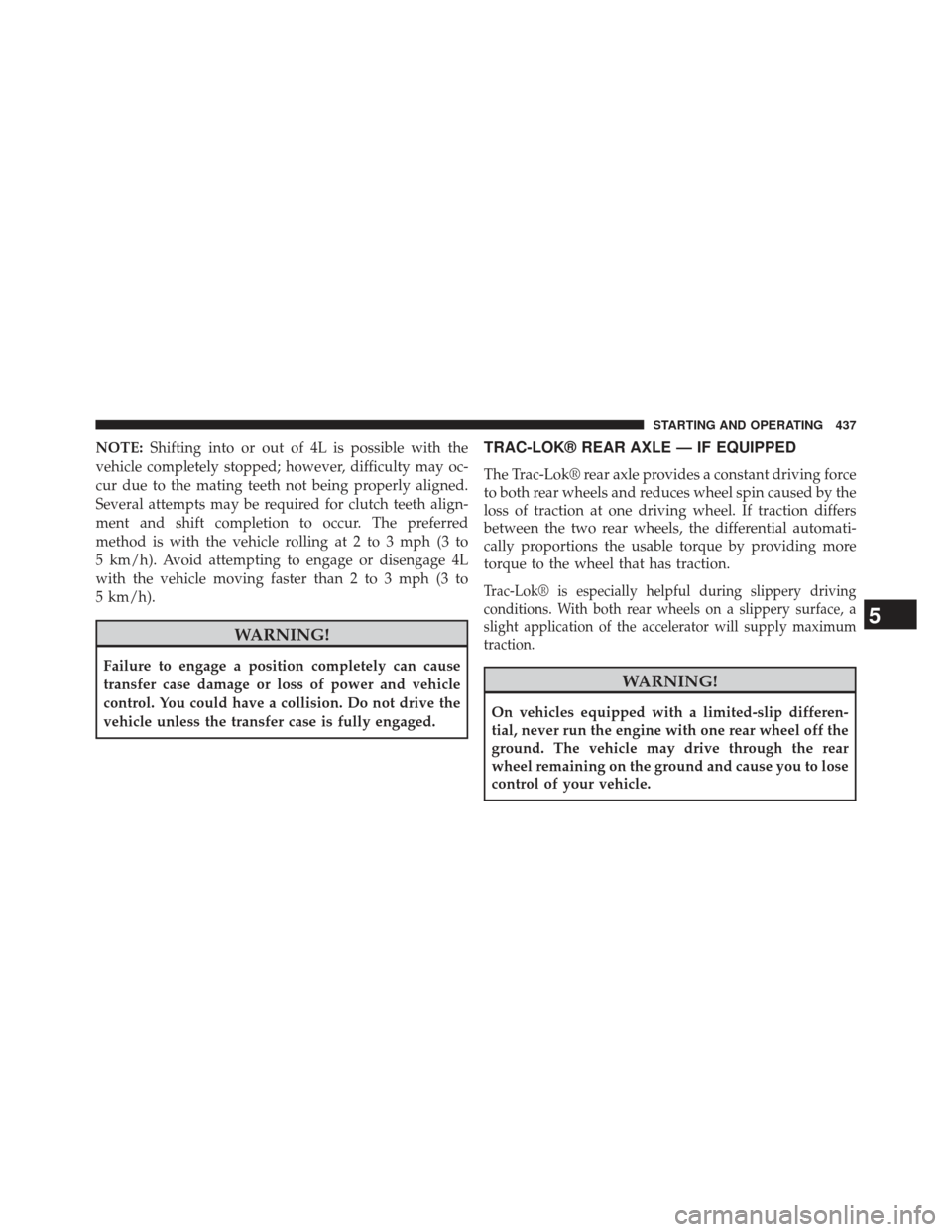
NOTE:Shifting into or out of 4L is possible with the
vehicle completely stopped; however, difficulty may oc-
cur due to the mating teeth not being properly aligned.
Several attempts may be required for clutch teeth align-
ment and shift completion to occur. The preferred
method is with the vehicle rolling at 2 to 3 mph (3 to
5 km/h). Avoid attempting to engage or disengage 4L
with the vehicle moving faster than 2 to 3 mph (3 to
5 km/h).
WARNING!
Failure to engage a position completely can cause
transfer case damage or loss of power and vehicle
control. You could have a collision. Do not drive the
vehicle unless the transfer case is fully engaged.
TRAC-LOK® REAR AXLE — IF EQUIPPED
The Trac-Lok® rear axle provides a constant driving force
to both rear wheels and reduces wheel spin caused by the
loss of traction at one driving wheel. If traction differs
between the two rear wheels, the differential automati-
cally proportions the usable torque by providing more
torque to the wheel that has traction.
Trac-Lok® is especially helpful during slippery driving
conditions. With both rear wheels on a slippery surface, a
slight application of the accelerator will supply maximum
traction.
WARNING!
On vehicles equipped with a limited-slip differen-
tial, never run the engine with one rear wheel off the
ground. The vehicle may drive through the rear
wheel remaining on the ground and cause you to lose
control of your vehicle.
5
STARTING AND OPERATING 437
Page 453 of 666

Driving Through Water
Extreme care should be taken crossing any type of water.
Water crossings should be avoided, if possible, and only
be attempted when necessary in a safe, responsible
manner. You should only drive through areas which are
designated and approved. You should tread lightly and
avoid damage to the environment. You should know
your vehicle’s abilities and be able to recover it if
something goes wrong. You should never stop or shut a
vehicle off when crossing deep water unless you ingested
water into the engine air intake. If the engine stalls, do
not attempt to restart it. Determine if it has ingested
water first. The key to any crossing is low and slow. Shift
into first gear (manual transmission), or DRIVE (auto-
matic transmission), with the transfer case in the 4L
(Low) position and proceed very slowly with a constant
slow speed {3 to 5 mph (5 to 8 km/h) maximum} and
light throttle. Keep the vehicle moving; do not try toaccelerate through the crossing. After crossing any water
higher than the bottom of the axle differentials, you
should inspect all of the vehicle fluids for signs of water
ingestion.
CAUTION!
•
Water ingestion into the axles, transmission, trans-
fer case, engine or vehicle interior can occur if you
drive too fast or through too deep of water. Water
can cause permanent damage to engine, driveline
or other vehicle components, and your brakes will
be less effective once wet and/or muddy.
• This vehicle is capable of crossing through water at
a depth of 30 inches (76 cm) at speeds no greater
than 5 mph (8 km/h). Water ingestion can occur
causing damage to your vehicle.
5
STARTING AND OPERATING 451
Page 463 of 666
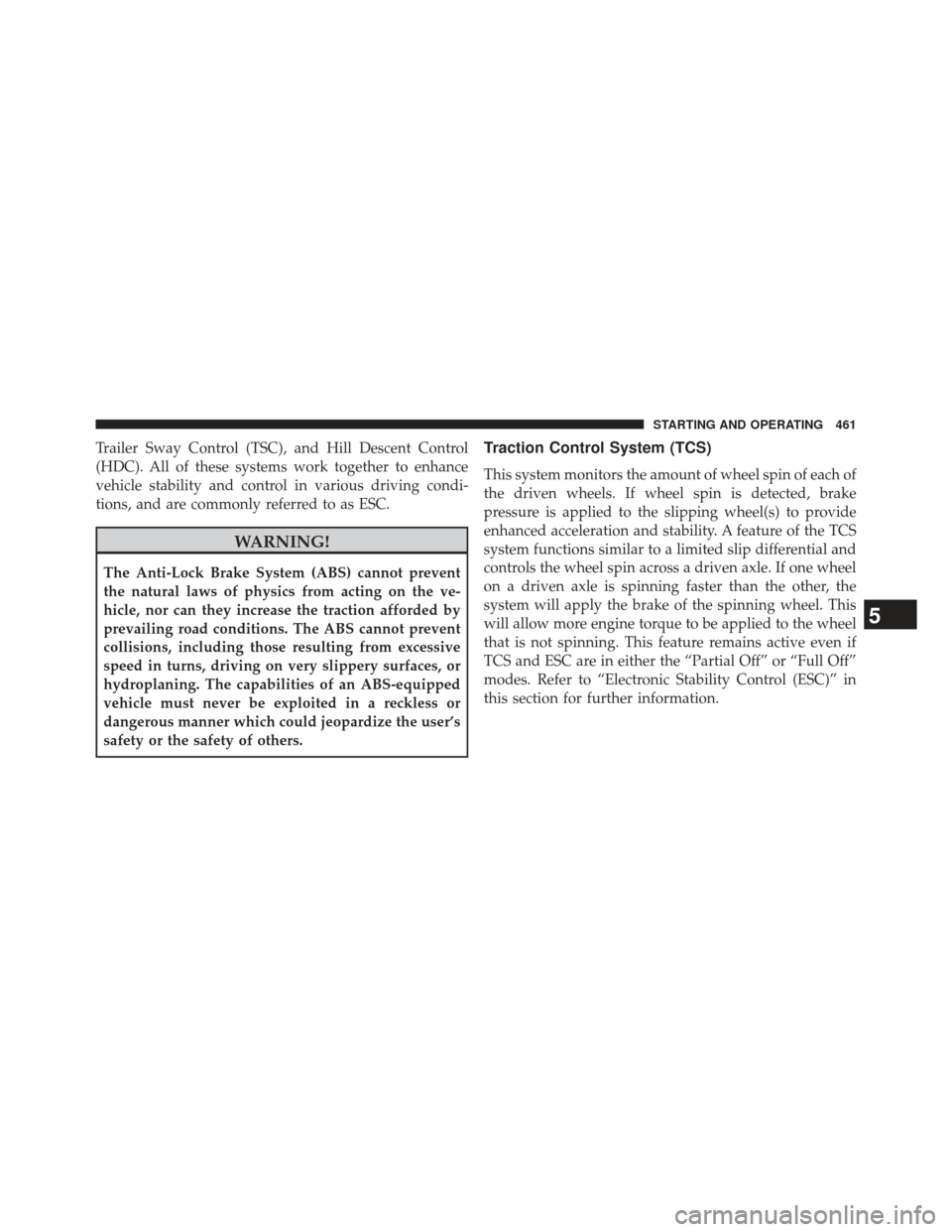
Trailer Sway Control (TSC), and Hill Descent Control
(HDC). All of these systems work together to enhance
vehicle stability and control in various driving condi-
tions, and are commonly referred to as ESC.
WARNING!
The Anti-Lock Brake System (ABS) cannot prevent
the natural laws of physics from acting on the ve-
hicle, nor can they increase the traction afforded by
prevailing road conditions. The ABS cannot prevent
collisions, including those resulting from excessive
speed in turns, driving on very slippery surfaces, or
hydroplaning. The capabilities of an ABS-equipped
vehicle must never be exploited in a reckless or
dangerous manner which could jeopardize the user’s
safety or the safety of others.
Traction Control System (TCS)
This system monitors the amount of wheel spin of each of
the driven wheels. If wheel spin is detected, brake
pressure is applied to the slipping wheel(s) to provide
enhanced acceleration and stability. A feature of the TCS
system functions similar to a limited slip differential and
controls the wheel spin across a driven axle. If one wheel
on a driven axle is spinning faster than the other, the
system will apply the brake of the spinning wheel. This
will allow more engine torque to be applied to the wheel
that is not spinning. This feature remains active even if
TCS and ESC are in either the “Partial Off” or “Full Off”
modes. Refer to “Electronic Stability Control (ESC)” in
this section for further information.
5
STARTING AND OPERATING 461
Page 622 of 666
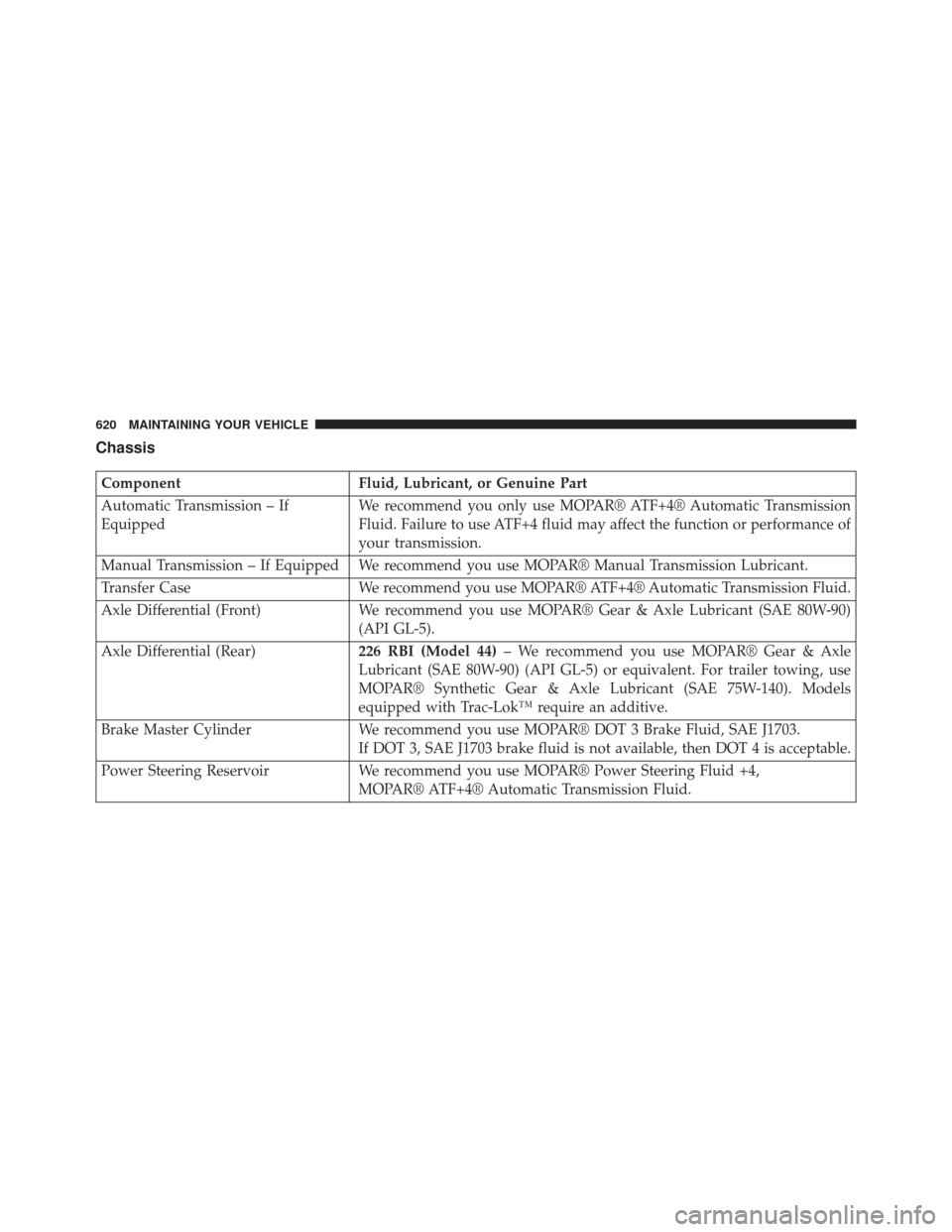
Chassis
ComponentFluid, Lubricant, or Genuine Part
Automatic Transmission – If
Equipped We recommend you only use MOPAR® ATF+4® Automatic Transmission
Fluid. Failure to use ATF+4 fluid may affect the function or performance of
your transmission.
Manual Transmission – If Equipped We recommend you use MOPAR® Manual Transmission Lubricant.
Transfer Case We recommend you use MOPAR® ATF+4® Automatic Transmission Fluid.
Axle Differential (Front) We recommend you use MOPAR® Gear & Axle Lubricant (SAE 80W-90)
(API GL-5).
Axle Differential (Rear) 226 RBI (Model 44)– We recommend you use MOPAR® Gear & Axle
Lubricant (SAE 80W-90) (API GL-5) or equivalent. For trailer towing, use
MOPAR® Synthetic Gear & Axle Lubricant (SAE 75W-140). Models
equipped with Trac-Lok™ require an additive.
Brake Master Cylinder We recommend you use MOPAR® DOT 3 Brake Fluid, SAE J1703.
If DOT 3, SAE J1703 brake fluid is not available, then DOT 4 is acceptable.
Power Steering Reservoir We recommend you use MOPAR® Power Steering Fluid +4,
MOPAR® ATF+4® Automatic Transmission Fluid.
620 MAINTAINING YOUR VEHICLE
Page 651 of 666
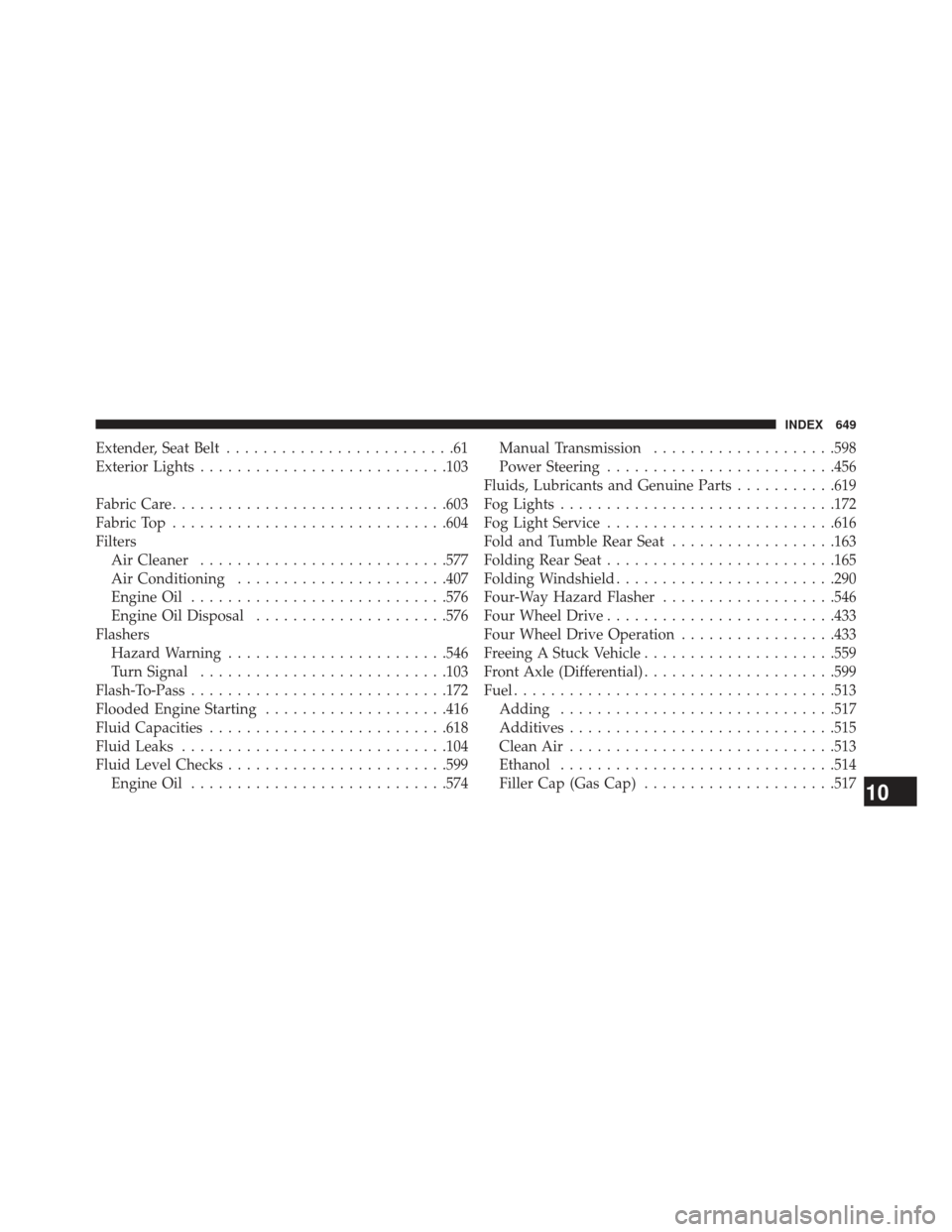
Extender, Seat Belt.........................61
Exterior Lights .......................... .103
Fabric Care ............................. .603
Fabric Top ............................. .604
Filters Air Cleaner .......................... .577
Air Conditioning ...................... .407
Engine Oil ........................... .576
Engine Oil Disposal .....................576
Flashers Hazard Warning ....................... .546
Turn Signal .......................... .103
Flash-To-Pass ........................... .172
Flooded Engine Starting ....................416
Fluid Capacities ......................... .618
Fluid Leaks ............................ .104
Fluid Level Checks ....................... .599
Engine Oil ........................... .574Manual Transmission
....................598
Power Steering ........................ .456
Fluids, Lubricants and Genuine Parts ...........619
Fog Lights ............................. .172
Fog Light Service ........................ .616
Fold and Tumble Rear Seat ..................163
Folding Rear Seat ........................ .165
Folding Windshield ....................... .290
Four-Way Hazard Flasher ...................546
Four Wheel Drive ........................ .433
Four Wheel Drive Operation .................433
Freeing A Stuck Vehicle .....................559
Front Axle (Differential) .....................599
Fuel .................................. .513
Adding ............................. .517
Additives ............................ .515
Clean Air ............................ .513
Ethanol ............................. .514
Filler
Cap (Gas Cap) .....................517
10
INDEX 649
Page 658 of 666
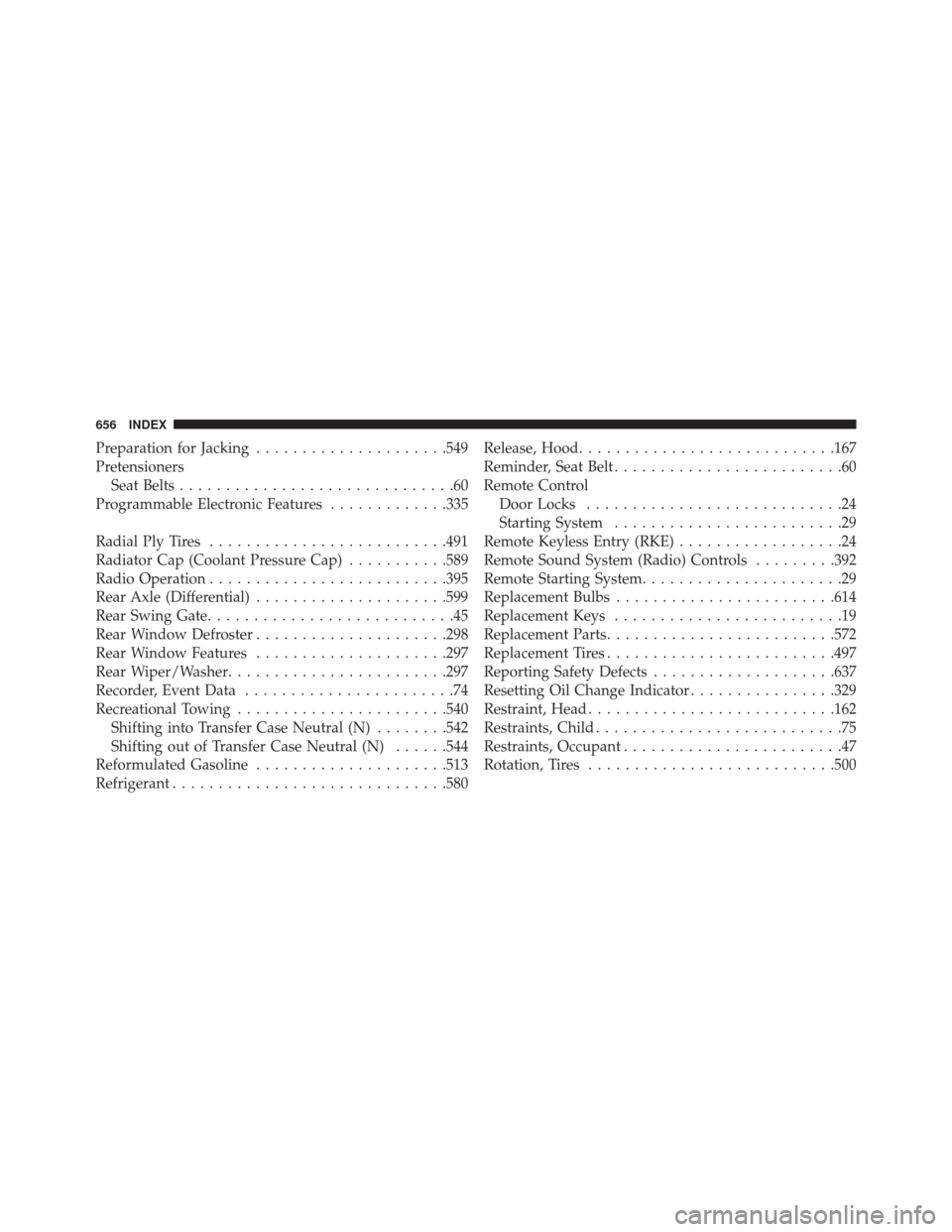
Preparation for Jacking.....................549
Pretensioners Seat Belts ..............................60
Programmable Electronic Features .............335
Radial Ply Tires ......................... .491
Radiator Cap (Coolant Pressure Cap) ...........589
Radio Operation ......................... .395
Rear Axle (Differential) .....................599
Rear Swing Gate ...........................45
Rear Window Defroster .....................298
Rear Window Features .....................297
Rear Wiper/Washer ....................... .297
Recorder, Event Data .......................74
Recreational Towing ...................... .540
Shifting into Transfer Case Neutral (N) ........542
Shifting out of Transfer Case Neutral (N) ......544
Reformulated Gasoline .....................513
Refrigerant ............................. .580Release, Hood
........................... .167
Reminder, Seat Belt .........................60
Remote Control Door Locks ............................24
Starting System .........................29
Remote Keyless Entry (RKE) ..................24
Remote Sound System (Radio) Controls .........392
Remote Starting System ......................29
Replacement Bulbs ....................... .614
Replacement Keys .........................19
Replacement Parts ........................ .572
Replacement Tires ........................ .497
Reporting Safety Defects ....................637
Resetting Oil Change Indicator ................329
Restraint, Head .......................... .162
Restraints, Child ...........................75
Restraints, Occupant ........................47
Rotation, Tires .......................... .500
656 INDEX